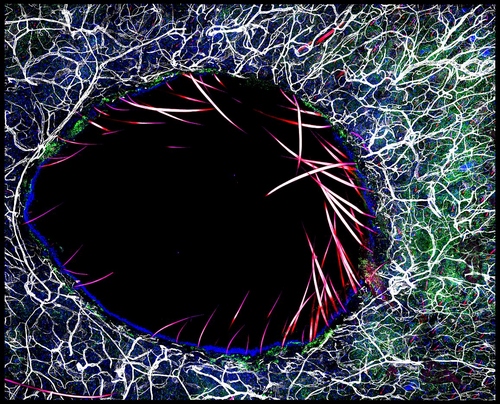NIH scientists find microbes on the skin of mice promote tissue healing, immunity
Insights may inform wound management techniques.
Beneficial bacteria (link is external) on the skin of lab mice work with the animals’ immune systems to defend against disease-causing microbes and accelerate wound healing, according to new research from scientists at the National Institute of Allergy and Infectious Diseases, part of the National Institutes of Health. Researchers say untangling similar mechanisms in humans may improve approaches to managing skin wounds and treating other damaged tissues.

Immunofluorescent image of immune cells surrounding a skin wound, enriched in the beneficial bacteria S. epidermidis.
Like humans and other mammals, mice are inhabited by large, diverse microbial populations collectively called the microbiome. While the microbiome is believed to have many beneficial functions across several organ systems, little is known about how the immune system responds to these harmless bacteria.
To investigate, NIAID scientists led by Yasmine Belkaid, Ph.D., chief of the Mucosal Immunology Section of NIAID’s Laboratory of Parasitic Diseases, observed the reaction of mouse immune cells to Staphylococcus epidermidis, a bacterium regularly found on human skin that does not normally cause disease. To their surprise, immune cells recognized S. epidermidis using evolutionarily ancient molecules called non-classical MHC molecules, which led to the production of unusual T cells (link is external) with genes associated with tissue healing and antimicrobial defense. In contrast, immune cells recognize disease-causing bacteria with classical MHC molecules, which lead to the production of T cells that stoke inflammation.
Researchers then took skin biopsies from two groups of mice—one group that had been colonized by S. epidermidis and another that had not. Over five days, the group that had been exposed to the beneficial bacteria experienced more tissue repair at the wound site and less evidence of inflammation. Dr. Belkaid’s team plans to next probe whether non-classical MHC molecules recognize friendly microbes on the skin of other mammals, including humans, and similarly benefit tissue repair. Eventually, mimicking the processes initiated by the microbiome may allow clinicians to accelerate wound healing and prevent dangerous infections, the researchers note.
Source: U.S. National Institutes of Health
- 278 reads
Human Rights
Ringing FOWPAL’s Peace Bell for the World:Nobel Peace Prize Laureates’ Visions and Actions

Protecting the World’s Cultural Diversity for a Sustainable Future

The Peace Bell Resonates at the 27th Eurasian Economic Summit

Declaration of World Day of the Power of Hope Endorsed by People in 158 Nations

Puppet Show I International Friendship Day 2020

